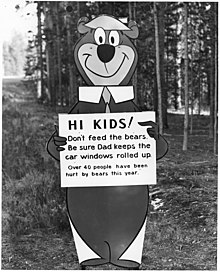Yogi Bear
Yogi Bear is an American cartoon character from the Hanna Barbera Studios. He first appeared in the cartoon series Hucky and his friends in 1958 , until he got his first series in 1961 with Yogi Bear .
Emergence
The temporary decline of cinema culture in the United States in the 1950s forced the production studio Metro-Goldwyn-Mayer to stop their animation production in 1957 and to lay off their employees in this division. The two animators William Hanna and Joseph Barbera then founded their own studio and were able to accommodate their first series The Ruff & Reddy Show on the television network NBC with the reputation they brought with them as producers of Tom and Jerry . The following year the series Hucky and his friends was created , which was sold as a syndicated program to the Columbia Pictures subsidiary Screen Gems and was sponsored from the beginning by the cereal producer Kellogg’s . A program consisted of three parts: in addition to a story of the blue dog Hucky, a story of the two mice Pixie and Dixie and one of Yogi Bear and his smaller companion Boo Boo were told. The series was the first cartoon series to receive an Emmy Award in 1959 and reached up to 16 million viewers worldwide.
Due to Yogi Bär's popularity, he received his own program named after him in 1961, a year before the original series was discontinued. The yogi bear stories were accompanied by stories about the mountain lion Snagglepuss , which was previously seen at Quick and his friends , and the duckling Yakky Doodle . It has been suggested that Yogi Bear was named after the popular baseball player Yogi Berra . Although a connection was denied, the public could not be convinced of a coincidence for a long time.
development
Yogi Bear lives in the series Yogi Bear in Jellystone Park, which was named in reference to Yellowstone National Park . Driven by an unreflective greed, he tries to steal the picnic baskets from the visitors there . His opponent is the ranger Smith, who wants to ensure peace and order in his park and cannot understand that Yogi does not eat nuts and berries like all other bears. Yogi's companion Boo Boo acts as his conscience, pointing out the ranger's condition. From the second season the she-bear Cindy Bär appears, whose favor Yogi tries to win. Yogi's motto in life, which he utters in almost every episode, is: “I am smarter than the average bear!” (In the original: “I'm smarter than the average bear!”).
The first television series was discontinued in 1962, but was constantly repeated in the television program. In 1964, the Hanna Barbera Studios' first cinema film, Yogi Bear's Adventure , appeared . Yogi initially appears as an instinct-controlled picnic thief as usual. When he is about to be removed from Jellystone Park and taken to a zoo, he remains undetected in the park. However, Cindy Bär volunteers to be brought to a zoo to be with him. Yogi goes on a voluntary journey for the first time in order to find his girlfriend again, Cindy Bär is drawn as a character for the first time.
Yogi Bär had his next appearance from 1973 in the series Yogis Gang , in which a number of characters from the Hanna Barbera Studios meet in Jellystone Park and decide to look for a place free of pollution and crime. They then travel the world on a flying ark. In the end, they return and begin to change the conditions in Jellystone Park and clear up the rubbish lying around there.
Series and films with Yogi Bear
Series
- 1958–1962: Hucky and Friends ( The Huckleberry Hound Show )
- 1958–1962: Yogi Bear ( The Yogi Bear Show )
- 1973–1975: Yogis Gang ( Yogi's Gang , German alternative title Yogis Arche Noah )
- 1977-1979: Scooby's All Star Laff-A-Lympics
- 1978–1979: Yogi's Galactic Adventure ( Yogi's Space Race )
- 1978-1979: Galaxy Goof-Ups
- 1985–1986: Yogi on a treasure hunt ( Yogi's Treasure Hunt )
- 1988–1989: The New Yogi Bear Show ( The New Yogi Bear Show )
- 1991–1992: Yo Yogi ( Yo Yogi! )
Movies
- 1964: Yogi Bear's Adventure ( Hey There, It's Yogi Bear )
- 1980: Yogi Bear's First Christmas ( Yogi's First Christmas , TV movie)
- 1982: Yogi Bear's big Christmas party ( Yogi Bear's All-Star Comedy Christmas Caper , TV movie)
- 1987: Adventure Above the Clouds ( Yogi Bear and the Magical Flight of the Spruce Goose , TV movie)
- 1987: Yogi Bear - Escape into the Unknown ( Yogi's Great Escape , TV movie)
- 1988: Yogi's abduction into space ( Yogi & the Invasion of the Space Bears , TV movie)
- 1988: Huckleberry Hound, the lonely cowboy ( The Good, the Bad, and Huckleberry Hound , movie made for TV)
- 1994: Yogi, der Osterbär ( Yogi the Easter Bear , TV movie)
- 1999: Boo Boo Runs Wild (TV short film)
- 1999: A Day in the Life of Ranger Smith (TV short film)
- 2010: Yogi Bear ( Yogi Bear )
literature
- Marc McDermott: Yogi Bear (PDF; 130 kB) . In: Ray B. Browne, Pat Browne (Eds.): The Guide to United States Popular Culture . Popular Press, 2001. ISBN 0879728213 . P. 944.
- Jeff Lenburg, Chris Bailey (Eds.): The Encyclopedia of Animated Cartoons , 3rd revised edition. Facts on file. 2008. ISBN 0816066000 . Pp. 676-677.
